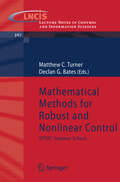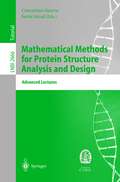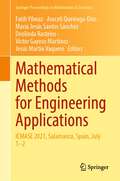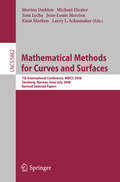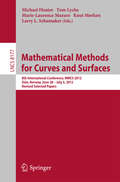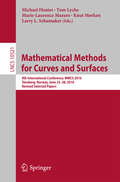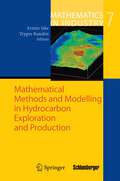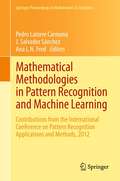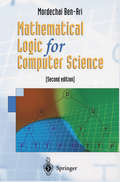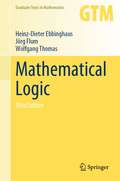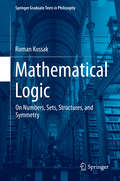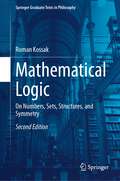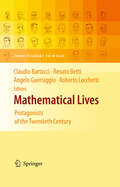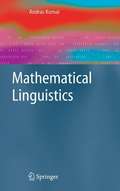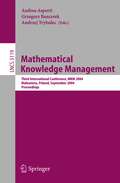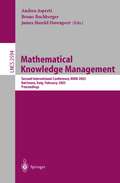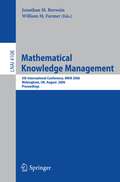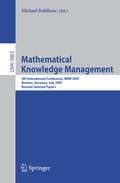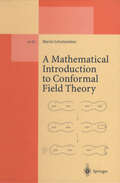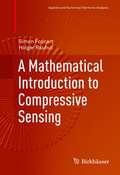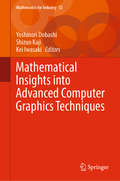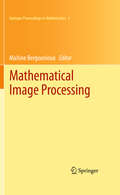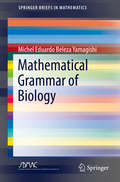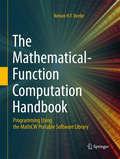- Table View
- List View
Mathematical Methods for Robust and Nonlinear Control: EPSRC Summer School (Lecture Notes in Control and Information Sciences #367)
by Matthew C. Turner Declan G. BatesThe underlying theory on which much modern robust and nonlinear control is based can be difficult to grasp. This volume is a collection of lecture notes presented by experts in advanced control engineering. The book is designed to provide a better grounding in the theory underlying several important areas of control. It is hoped the book will help the reader to apply otherwise abstruse ideas of nonlinear control in a variety of real systems.
Mathematical Methods for Protein Structure Analysis and Design: Advanced Lectures (Lecture Notes in Computer Science #2666)
by Concettina Guerra Sorin IstrailThe papers collected in this volume reproduce contributions by leading sch- arstoaninternationalschoolandworkshopwhichwasorganizedandheldwith thegoaloftakinga snapshotofadiscipline undertumultuous growth. Indeed, the area of protein folding, docking and alignment is developing in response to needs for a mix of heterogeneous expertise spanning biology, chemistry, mathematics, computer science, and statistics, among others. Some of the problems encountered in this area are not only important for the scienti?c challenges they pose, but also for the opportunities they disclose intermsofmedicalandindustrialexploitation. Atypicalexampleiso?eredby protein-drug interaction (docking), a problem posing daunting computational problems at the crossroads of geometry, physics and chemistry, and, at the same time, a problem with unimaginable implications for the pharmacopoeia of the future. The schoolfocused on problems posed by the study of the mechanisms - hind protein folding, and explored di?erent ways of attacking these problems under objective evaluations of the methods. Together with a relatively small core of consolidated knowledge and tools, important re?ections were brought to this e?ort by studies in a multitude of directions and approaches. It is obviously impossible to predict which, if any, among these techniques will prove completely successful, but it is precisely the implicit dialectic among them that best conveys the current ?avor of the ?eld. Such unique diversity and richness inspired the format of the meeting, and also explains the slight departure of the present volume from the typical format in this series: the exposition of the current sediment is complemented here by a selection of quali?ed specialized contributions.
Mathematical Methods for Engineering Applications: ICMASE 2021, Salamanca, Spain, July 1–2 (Springer Proceedings in Mathematics & Statistics #384)
by Fatih Yilmaz Araceli Queiruga-Dios María Jesús Santos Sánchez Deolinda Rasteiro Víctor Gayoso Martínez Jesús Martín VaqueroThis proceedings volume gathers selected, peer-reviewed papers presented at the 2nd International Conference on Mathematics and its Applications in Science and Engineering – ICMASE 2021, which was virtually held on July 1-2, 2021 by the University of Salamanca, Spain. Works included in this book cover applications of mathematics both in engineering research and in real-world problems, touching topics such as difference equations, number theory, optimization, and more. The list of applications includes the modeling of mechanical structures, the shape of machines, and the growth of a population, expanding to fields like information security and cryptography. Advances in teaching and learning mathematics in the context of engineering courses are also covered.This volume can be of special interest to researchers in applied mathematics and engineering fields, as well as practitioners seeking studies that address real-life problems in engineering.
Mathematical Methods for Curves and Surfaces: 7th International Conference, MMCS 2008, Tønsberg, Norway, June 26-July 1, 2008, Revised Selected Papers (Lecture Notes in Computer Science #5862)
by Morten Dæhlen Michael S. Floater Tom Lyche Jean-Louis Merrien Knut Morken Larry L. SchumakerMathematical Methods for Curves and Surfaces: 8th International Conference, MMCS 2012, Oslo, Norway, June 28 - July 3, 2012, Revised Selected Papers (Lecture Notes in Computer Science #8177)
by Michael Floater Tom Lyche Marie-Laurence Mazure Knut Moerken Larry L. SchumakerThis volume constitutes the thoroughly refereed post-conference proceedings of the 8th International Conference on Mathematical Methods for Curves and Surfaces, MMCS 2012, held in Oslo, Norway, in June/July 2012. The 28 revised full papers presented were carefully reviewed and selected from 135 submissions. The topics range from mathematical analysis of various methods to practical implementation on modern graphics processing units. The papers reflect the newest developments in these fields and also point to the latest literature.
Mathematical Methods for Curves and Surfaces: 9th International Conference, MMCS 2016, Tønsberg, Norway, June 23–28, 2016, Revised Selected Papers (Lecture Notes in Computer Science #10521)
by Michael Floater Tom Lyche Marie-Laurence Mazure Knut Mørken Larry L. SchumakerThis volume constitutes the thoroughly refereed post-conference proceedings of the 9th International Conference on Mathematical Methods for Curves and Surfaces, MMCS 2016, held in Tønsberg, Norway, in June 2016. The 17 revised full papers presented were carefully reviewed and selected from 115 submissions. The topics range from mathematical theory to industrial applications.
Mathematical Methods and Modelling in Hydrocarbon Exploration and Production (Mathematics in Industry #7)
by Armin Iske Trygve RandenHydrocarbon exploration and production incorporate great technology challenges for the oil and gas industry. In order to meet the world's future demand for oil and gas, further technological advance is needed, which in turn requires research across multiple disciplines, including mathematics, geophysics, geology, petroleum engineering, signal processing, and computer science. This book addresses important aspects and fundamental concepts in hydrocarbon exploration and production. Moreover, new developments and recent advances in the relevant research areas are discussed, whereby special emphasis is placed on mathematical methods and modelling. The book reflects the multi-disciplinary character of the hydrocarbon production workflow, ranging from seismic data imaging, seismic analysis and interpretation and geological model building, to numerical reservoir simulation. Various challenges concerning the production workflow are discussed in detail. The thirteen chapters of this joint work, authored by international experts from academic and industrial institutions, include survey papers of expository character as well as original research articles. Large parts of the material presented in this book were developed between November 2000 and April 2004 through the European research and training network NetAGES, "Network for Automated Geometry Extraction from Seismic". The new methods described here are currently being implemented as software tools at Schlumberger Stavanger Research, one of the world's largest service providers to the oil industry.
Mathematical Methodologies in Pattern Recognition and Machine Learning: Contributions from the International Conference on Pattern Recognition Applications and Methods, 2012 (Springer Proceedings in Mathematics & Statistics #30)
by J. Salvador Sánchez Pedro Latorre Carmona Ana L. N. FredThis volume features key contributions from the International Conference on Pattern Recognition Applications and Methods, (ICPRAM 2012,) held in Vilamoura, Algarve, Portugal from February 6th-8th, 2012. The conference provided a major point of collaboration between researchers, engineers and practitioners in the areas of Pattern Recognition, both from theoretical and applied perspectives, with a focus on mathematical methodologies. Contributions describe applications of pattern recognition techniques to real-world problems, interdisciplinary research, and experimental and theoretical studies which yield new insights that provide key advances in the field. This book will be suitable for scientists and researchers in optimization, numerical methods, computer science, statistics and for differential geometers and mathematical physicists.
Mathematical Masterpieces: Further Chronicles by the Explorers (Undergraduate Texts in Mathematics)
by Art Knoebel Reinhard Laubenbacher Jerry Lodder David PengelleyIntended for juniors and seniors majoring in mathematics, as well as anyone pursuing independent study, this book traces the historical development of four different mathematical concepts by presenting readers with the original sources. Each chapter showcases a masterpiece of mathematical achievement, anchored to a sequence of selected primary sources. The authors examine the interplay between the discrete and continuous, with a focus on sums of powers. They then delineate the development of algorithms by Newton, Simpson and Smale. Next they explore our modern understanding of curvature, and finally they look at the properties of prime numbers. The book includes exercises, numerous photographs, and an annotated bibliography.
Mathematical Logic for Computer Science
by Mordechai Ben-AriThis is a mathematics textbook with theorems and proofs. The choice of topics has been guided by the needs of computer science students. The method of semantic tableaux provides an elegant way to teach logic that is both theoretically sound and yet sufficiently elementary for undergraduates. In order to provide a balanced treatment of logic, tableaux are related to deductive proof systems. The book presents various logical systems and contains exercises. Still further, Prolog source code is available on an accompanying Web site. The author is an Associate Professor at the Department of Science Teaching, Weizmann Institute of Science.
Mathematical Logic (Graduate Texts in Mathematics #291)
by Heinz-Dieter Ebbinghaus Jörg Flum Wolfgang ThomasThis introduction to first-order logic clearly works out the role of first-order logic in the foundations of mathematics, particularly the two basic questions of the range of the axiomatic method and of theorem-proving by machines. It covers several advanced topics not commonly treated in introductory texts, such as Fraïssé's characterization of elementary equivalence, Lindström's theorem on the maximality of first-order logic, and the fundamentals of logic programming.
Mathematical Logic: On Numbers, Sets, Structures, and Symmetry (Springer Graduate Texts in Philosophy #3)
by Roman KossakThis book, presented in two parts, offers a slow introduction to mathematical logic, and several basic concepts of model theory, such as first-order definability, types, symmetries, and elementary extensions. Its first part, Logic Sets, and Numbers, shows how mathematical logic is used to develop the number structures of classical mathematics. The exposition does not assume any prerequisites; it is rigorous, but as informal as possible. All necessary concepts are introduced exactly as they would be in a course in mathematical logic; but are accompanied by more extensive introductory remarks and examples to motivate formal developments. The second part, Relations, Structures, Geometry, introduces several basic concepts of model theory, such as first-order definability, types, symmetries, and elementary extensions, and shows how they are used to study and classify mathematical structures. Although more advanced, this second part is accessible to the reader who is either already familiar with basic mathematical logic, or has carefully read the first part of the book. Classical developments in model theory, including the Compactness Theorem and its uses, are discussed. Other topics include tameness, minimality, and order minimality of structures. The book can be used as an introduction to model theory, but unlike standard texts, it does not require familiarity with abstract algebra. This book will also be of interest to mathematicians who know the technical aspects of the subject, but are not familiar with its history and philosophical background.
Mathematical Logic: On Numbers, Sets, Structures, and Symmetry (Springer Graduate Texts in Philosophy #4)
by Roman KossakThis textbook is a second edition of the successful, Mathematical Logic: On Numbers, Sets, Structures, and Symmetry. It retains the original two parts found in the first edition, while presenting new material in the form of an added third part to the textbook. The textbook offers a slow introduction to mathematical logic, and several basic concepts of model theory, such as first-order definability, types, symmetries, and elementary extensions. Part I, Logic Sets, and Numbers, shows how mathematical logic is used to develop the number structures of classical mathematics. All necessary concepts are introduced exactly as they would be in a course in mathematical logic; but are accompanied by more extensive introductory remarks and examples to motivate formal developments. The second part, Relations, Structures, Geometry, introduces several basic concepts of model theory, such as first-order definability, types, symmetries, and elementary extensions, and shows how they are usedto study and classify mathematical structures. The added Part III to the book is closer to what one finds in standard introductory mathematical textbooks. Definitions, theorems, and proofs that are introduced are still preceded by remarks that motivate the material, but the exposition is more formal, and includes more advanced topics. The focus is on the notion of countable categoricity, which analyzed in detail using examples from the first two parts of the book. This textbook is suitable for graduate students in mathematical logic and set theory and will also be of interest to mathematicians who know the technical aspects of the subject, but are not familiar with its history and philosophical background.
Mathematical Lives: Protagonists of the Twentieth Century From Hilbert to Wiles
by Roberto Lucchetti Kim Williams Claudio Bartocci Renato Betti Angelo GuerraggioSteps forward in mathematics often reverberate in other scientific disciplines, and give rise to innovative conceptual developments or find surprising technological applications. This volume brings to the forefront some of the proponents of the mathematics of the twentieth century, who have put at our disposal new and powerful instruments for investigating the reality around us. The portraits present people who have impressive charisma and wide-ranging cultural interests, who are passionate about defending the importance of their own research, are sensitive to beauty, and attentive to the social and political problems of their times. What we have sought to document is mathematics’ central position in the culture of our day. Space has been made not only for the great mathematicians but also for literary texts, including contributions by two apparent interlopers, Robert Musil and Raymond Queneau, for whom mathematical concepts represented a valuable tool for resolving the struggle between ‘soul and precision.’
Mathematical Linguistics (Advanced Information and Knowledge Processing)
by Andras KornaiMathematical Linguistics introduces the mathematical foundations of linguistics to computer scientists, engineers, and mathematicians interested in natural language processing. The book presents linguistics as a cumulative body of knowledge from the ground up: no prior knowledge of linguistics is assumed. As the first textbook of its kind, this book is useful for those in information science and in natural language technologies.
Mathematical Knowledge Management: Third International Conference, MKM 2004, Bialowieza, Poland, September 19-21, 2004, Proceedings (Lecture Notes in Computer Science #3119)
by Andrea Asperti Grzegorz Bancerek Andrzej TrybulecMathematical Knowledge Management: Second International Conference, MKM 2003 Bertinoro, Italy, February 16-18, 2003 (Lecture Notes in Computer Science #2594)
by Andrea Asperti Bruno Buchberger James Harold DavenportMathematical Knowledge Management: 5th International Conference, MKM 2006, Wokingham, UK, August 11-12, 2006, Proceedings (Lecture Notes in Computer Science #4108)
by Jonathan Borwein William M. FarmerThis book constitutes the refereed proceedings of the 5th International Conference on Mathematical Knowledge Management, MKM 2006, held in Wokingham, UK, August 2006. The book presents 22 revised full papers. Coverage extends to the mathematical knowledge management at the intersection of mathematics, computer science, library science, and scientific publishing. The papers are organized in topical sections on proof representations, proof processing, knowledge extraction, knowledge representation, as well as systems and tools.
Mathematical Knowledge Management: 4th International Conference, MKM 2005, Bremen, Germany, July 15-17, 2005, Revised Selected Papers (Lecture Notes in Computer Science #3863)
by Michael KohlhaseThis book constitutes the thoroughly refereed post-proceedings of the 4th International Conference on Mathematical Knowledge Management. The 26 revised full papers presented were carefully selected during two rounds of reviewing and improvement from 38 submissions. The papers cover mathematical knowledge management. Topics range from foundations and the representational and document-structure aspects of mathematical knowledge, over process questions like authoring, migration, and consistency management by automated theorem proving to applications in e-learning and case studies.
A Mathematical Introduction to Conformal Field Theory: Based on a Series of Lectures given at the Mathematisches Institut der Universität Hamburg (Lecture Notes in Physics Monographs #43)
by Martin SchottenloherPart I gives a detailed, self-contained and mathematically rigorous exposition of classical conformal symmetry in n dimensions and its quantization in two dimensions. The conformal groups are determined and the appearence of the Virasoro algebra in the context of the quantization of two-dimensional conformal symmetry is explained via the classification of central extensions of Lie algebras and groups. Part II surveys more advanced topics of conformal field theory such as the representation theory of the Virasoro algebra, conformal symmetry within string theory, an axiomatic approach to Euclidean conformally covariant quantum field theory and a mathematical interpretation of the Verlinde formula in the context of moduli spaces of holomorphic vector bundles on a Riemann surface.
A Mathematical Introduction to Compressive Sensing (Applied and Numerical Harmonic Analysis)
by Simon Foucart Holger RauhutAt the intersection of mathematics, engineering, and computer science sits the thriving field of compressive sensing. Based on the premise that data acquisition and compression can be performed simultaneously, compressive sensing finds applications in imaging, signal processing, and many other domains. In the areas of applied mathematics, electrical engineering, and theoretical computer science, an explosion of research activity has already followed the theoretical results that highlighted the efficiency of the basic principles. The elegant ideas behind these principles are also of independent interest to pure mathematicians.A Mathematical Introduction to Compressive Sensing gives a detailed account of the core theory upon which the field is build. With only moderate prerequisites, it is an excellent textbook for graduate courses in mathematics, engineering, and computer science. It also serves as a reliable resource for practitioners and researchers in these disciplines who want to acquire a careful understanding of the subject. A Mathematical Introduction to Compressive Sensing uses a mathematical perspective to present the core of the theory underlying compressive sensing.
Mathematical Insights into Advanced Computer Graphics Techniques (Mathematics For Industry Ser. #32)
by Yoshinori Dobashi Shizuo Kaji Kei IwasakiThis book presents cutting-edge developments in the advanced mathematical theories utilized in computer graphics research – fluid simulation, realistic image synthesis, and texture, visualization and digital fabrication. A spin-off book from the International Symposium on Mathematical Progress in Expressive Image Synthesis in 2016 and 2017 (MEIS2016/2017) held in Fukuoka, Japan, it includes lecture notes and an expert introduction to the latest research presented at the symposium. The book offers an overview of the emerging interdisciplinary themes between computer graphics and driven mathematic theories, such as discrete differential geometry. Further, it highlights open problems in those themes, making it a valuable resource not only for researchers, but also for graduate students interested in computer graphics and mathematics.
Mathematical Image Processing: University of Orléans, France, March 29th - April 1st, 2010 (Springer Proceedings in Mathematics #5)
by Maïtine BergouniouxThe contributions appearing in this volume are a snapshot of the different topics that were discussed during the Second Conference "Mathematics and Image Processing” held at the University of Orléans in 2010. They mainly concern, image reconstruction, texture extraction and image classification and involve a variety of different methods and applications. Therefore it was impossible to split the papers into generic groups which is why they are presented in alphabetic order. However they mainly concern: texture analysis (5 papers) with different techniques (variational analysis, wavelet and morphological component analysis, fractional Brownian fields), geometrical methods (2 papers ) for restoration and invariant feature detection, classification (with multifractal analysis), neurosciences imaging and analysis of Multi-Valued Images.
Mathematical Grammar of Biology (SpringerBriefs in Mathematics)
by Michel Eduardo YamagishiThis seminal, multidisciplinary book shows how mathematics can be used to study the first principles of DNA. Most importantly, it enriches the so-called “Chargaff’s grammar of biology” by providing the conceptual theoretical framework necessary to generalize Chargaff’s rules. Starting with a simple example of DNA mathematical modeling where human nucleotide frequencies are associated to the Fibonacci sequence and the Golden Ratio through an optimization problem, its breakthrough is showing that the reverse, complement and reverse-complement operators defined over oligonucleotides induce a natural set partition of DNA words of fixed-size. These equivalence classes, when organized into a matrix form, reveal hidden patterns within the DNA sequence of every living organism. Intended for undergraduate and graduate students both in mathematics and in life sciences, it is also a valuable resource for researchers interested in studying invariant genomic properties.
The Mathematical-Function Computation Handbook: Programming Using the MathCW Portable Software Library
by Nelson H.F. BeebeThis highly comprehensive handbook provides a substantial advance in the computation of elementary and special functions of mathematics, extending the function coverage of major programming languages well beyond their international standards, including full support for decimal floating-point arithmetic. Written with clarity and focusing on the C language, the work pays extensive attention to little-understood aspects of floating-point and integer arithmetic, and to software portability, as well as to important historical architectures. It extends support to a future 256-bit, floating-point format offering 70 decimal digits of precision.Select Topics and Features: references an exceptionally useful, author-maintained MathCW website, containing source code for the book’s software, compiled libraries for numerous systems, pre-built C compilers, and other related materials; offers a unique approach to covering mathematical-function computation using decimal arithmetic; provides extremely versatile appendices for interfaces to numerous other languages: Ada, C#, C++, Fortran, Java, and Pascal; presupposes only basic familiarity with computer programming in a common language, as well as early level algebra; supplies a library that readily adapts for existing scripting languages, with minimal effort; supports both binary and decimal arithmetic, in up to 10 different floating-point formats; covers a significant portion (with highly accurate implementations) of the U.S National Institute of Standards and Technology’s 10-year project to codify mathematical functions.This highly practical text/reference is an invaluable tool for advanced undergraduates, recording many lessons of the intermingled history of computer hardware and software, numerical algorithms, and mathematics. In addition, professional numerical analysts and others will find the handbook of real interest and utility because it builds on research by the mathematical software community over the last four decades.
